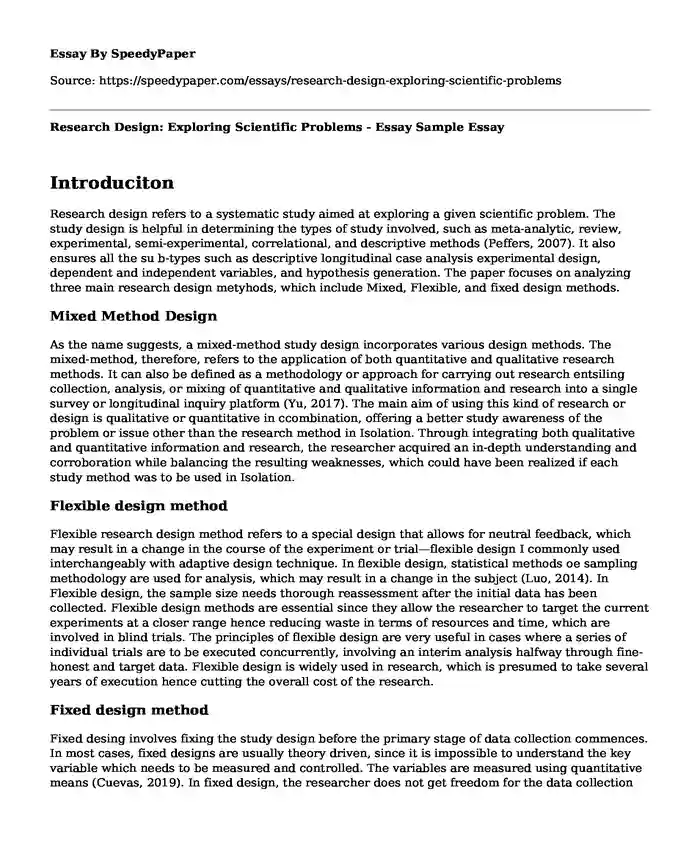
| Type of paper: | Essay |
| Categories: | Health and Social Care Medicine Science Healthcare |
| Pages: | 3 |
| Wordcount: | 752 words |
Introduciton
Research design refers to a systematic study aimed at exploring a given scientific problem. The study design is helpful in determining the types of study involved, such as meta-analytic, review, experimental, semi-experimental, correlational, and descriptive methods (Peffers, 2007). It also ensures all the su b-types such as descriptive longitudinal case analysis experimental design, dependent and independent variables, and hypothesis generation. The paper focuses on analyzing three main research design metyhods, which include Mixed, Flexible, and fixed design methods.
Mixed Method Design
As the name suggests, a mixed-method study design incorporates various design methods. The mixed-method, therefore, refers to the application of both quantitative and qualitative research methods. It can also be defined as a methodology or approach for carrying out research entsiling collection, analysis, or mixing of quantitative and qualitative information and research into a single survey or longitudinal inquiry platform (Yu, 2017). The main aim of using this kind of research or design is qualitative or quantitative in ccombination, offering a better study awareness of the problem or issue other than the research method in Isolation. Through integrating both qualitative and quantitative information and research, the researcher acquired an in-depth understanding and corroboration while balancing the resulting weaknesses, which could have been realized if each study method was to be used in Isolation.
Flexible design method
Flexible research design method refers to a special design that allows for neutral feedback, which may result in a change in the course of the experiment or trial—flexible design I commonly used interchangeably with adaptive design technique. In flexible design, statistical methods oe sampling methodology are used for analysis, which may result in a change in the subject (Luo, 2014). In Flexible design, the sample size needs thorough reassessment after the initial data has been collected. Flexible design methods are essential since they allow the researcher to target the current experiments at a closer range hence reducing waste in terms of resources and time, which are involved in blind trials. The principles of flexible design are very useful in cases where a series of individual trials are to be executed concurrently, involving an interim analysis halfway through fine-honest and target data. Flexible design is widely used in research, which is presumed to take several years of execution hence cutting the overall cost of the research.
Fixed design method
Fixed desing involves fixing the study design before the primary stage of data collection commences. In most cases, fixed designs are usually theory driven, since it is impossible to understand the key variable which needs to be measured and controlled. The variables are measured using quantitative means (Cuevas, 2019). In fixed design, the researcher does not get freedom for the data collection process. Therefore, fixed design entails quantitative means in defining a solution for a given problem domain.
Methodological Triangulation
when conducting research between two groups such as IT and Business, data triangulation may be used hence combining both uses of questionnaires and research documents. The process involves a researcher choosing to design questionnaires for quantitative research methodology while refereeing to research documents on a given area of study for both groups (Triangulation, 2017). By adopting the triangulation technique, the results obtained from the two data collection techniques are then combined to assure the validity of the research on the same topic. The main emphasis of triangulation is to capture different data dimensions of a given phenomenon.
References
Cuevas, A. (2019). Linear functional regression: the case of fixed design and functional response. Canadian Journal of Statistics, 30(2), 285-300. https://onlinelibrary.wiley.com/doi/abs/10.2307/3315952?casa_token=56n8c1RM4IoAAAAA:NbVNAwrW1vrQkBKyv2cfI85oukVFtZ7oaHdvfnELBMBNL3VSGseVzQC59cORjLkKdXMgPBJn37StNXxr
Luo, B. (2014). Flexible design method for multi-repeater wireless power transfer system based on coupled resonator bandpass filter model. IEEE Transactions on Circuits and Systems I: Regular Papers, 61(11), 3288-3297. https://ieeexplore.ieee.org/abstract/document/6866232/?casa_token=ZP5i6i3y10cAAAAA:oNK3sMNzmFKwqp2hRKR7_XkFFiXCB-GN3LSK7PpFoa1IauS_jIM6PtnxYZIM_lFsGlkIeFlq5uijXw
Peffers, K. (2007). A design science research methodology for information systems research. Journal of management information systems, 24(3), 45-77. https://www.tandfonline.com/doi/abs/10.2753/MIS0742-1222240302?casa_token=_doWmMnlSeMAAAAA:c1YdITYT6szV_9r3WuWkTRJHcWaBLAS6oQZ2y8dKRycCSqxXIloPorTnHESC2hHX6Fqo0SAne2PLDA5o
Triangulation, D. S. (2017). The use of triangulation in qualitative research. In Oncology nursing forum (Vol. 41, No. 5, p. 545). https://www.sciencedirect.com/science/article/pii/S1077314297905476
Yu, X. (2017). A mixed design approach for probabilistic structural durability. Structural optimization, 14(2-3), 81-90. https://link.springer.com/content/pdf/10.1007/BF01812509.pdf
Cite this page
Research Design: Exploring Scientific Problems - Essay Sample. (2023, Oct 15). Retrieved from https://speedypaper.com/essays/research-design-exploring-scientific-problems
Request Removal
If you are the original author of this essay and no longer wish to have it published on the SpeedyPaper website, please click below to request its removal:
- Anthropology Essay Sample: The Machine Zone
- Essay Example on the Effect of Caffeine Consumption on Individuals with ADHD
- Free Essay Example - Depression Guidelines
- Free Essay: Case Analysis Exercise
- Traumatic Brain Injury Patient - Free Essay
- Covid-19: HR Chiefs Need to Rethink Talent Management Post-Pandemic - Essay Sample
- Nursing with a Servant's Heart: Holistic Care in Practice - Essay Sample
Popular categories




